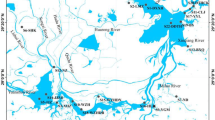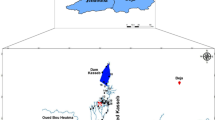Abstract
Levels of radiocesium (134Cs + 137Cs) contamination in lake water, bottom sediment, plankton, and fish were investigated in three geographically separated lakes in Fukushima Prefecture (Lake Hayama, Lake Akimoto, and Lake Tagokura) between June 2012 and November 2013. Levels of contamination differed among the three lakes, with the highest levels of each measured component in Lake Hayama, followed by Lake Akimoto, and the least contamination in Lake Tagokura. Among the lakes, the magnitude of contamination decreased with distance from the Fukushima Dai-ichi Nuclear Power Plant. Mean radiocesium concentrations were higher in piscivorous fish than in other fish, possibly reflecting differences in trophic level. The radiocesium concentrations in some fish species decreased significantly by 33–65 % during the period between 2012 and 2013. Radiocesium concentrations of the lake water, bottom sediment, plankton, and fish were significantly correlated with surface soil radiocesium content near lake sites.


Similar content being viewed by others
References
Nuclear Regulation Authority (2014) Monitoring information of environmental radioactivity level. http://radioactivity.nsr.go.jp/en/. Accessed 5 Dec 2014
Kobayashi T, Nagai H, Chino M, Kawamura H (2013) Source term estimation of atmospheric release due to the Fukushima Dai-ichi Nuclear Power Plant accident by atmospheric and oceanic dispersion simulations. J Nucl Sci Technol 50:255–264
Stohl A, Seibert P, Wotawa G, Arnold D, Burkhart JF, EcKhardt S, Tapia C, Vargas A, Yasunari TJ (2012) Xenon-133 and caesium-137 releases into the atmosphere from the Fukushima Dai-ichi nuclear power plant: determination of the source term, atmospheric dispersion, and deposition. Atmos Chem Phys 12:2313–2343
Matsunaga T, Koarashi J, Atarashi-Andoh M, Nagao S, Sato T, Nagai H (2013) Comparison of the vertical distributions of Fukushima nuclear accident radiocesium in soil before and after the first rainy season, with physicochemical and mineralogical interpretations. Sci Total Environ 447:301–314
Rowan DJ, Chant LA, Rasmussen JB (1998) The fate of radiocesium in freshwater communities—Why is biomagnification variable both within and between species? J Environ Radioact 40:15–36
Gustafson PF, Brar SS, Muniak SE (1966) Caesium-137 in edible freshwater fish. Nature 211:843–844
Rowan DJ, Rasmussen JB (1994) Bioaccumulation of radiocesium by fish: the influence of physicochemical factors and trophic structure. Can J Fish Aquat Sci 51:2388–2410
Mizuno T, Kubo H (2013) Overview of active cesium contamination of freshwater fish in Fukushima and Eastern Japan. Sci Rep 3:1742
Iguchi K, Fujimoto K, Kaeriyama H, Tomiya A, Enomoto M, Abe S, Ishida T (2013) Cesium-137 discharge into the freshwater fishery ground of grazing fish, ayu Plecoglossus altivelis after the March 2011 Fukushima nuclear accident. Fish Sci 79:983–988
Yamamoto S, Yokoduka T, Fujimoto K, Takagi K, Ono T (2014) Radiocesium concentrations in the muscle and eggs of salmonids from Lake Chuzenji, Japan, after the Fukushima fallout. J Fish Biol 84:1607–1613
Kaeriyama H, Ambe D, Shimizu Y, Fujimoto K, Ono T, YonezakiS Kato Y, Matsunaga H, Minami H, Nakatsuka S, Watanabe T (2013) Direct observation of 134Cs and137Cs in surface seawater in the western and central North Pacific after the Fukushima Dai-ichi nuclear power plant accident. Biogeosciences 10:4287–4295
Kaeriyama H, Shimizu Y, Ambe D, Masujima M, Shigenobu Y, Fujimoto K, Ono T, Nishiuchi K, Taneda T, Kurogi H, Setou T, Sugisaki H, Ichikawa T, Hidaka K, Hiroe Y, Kusaka A, Kodama T, Kuriyama M, Morita H, Nakata K, Morinaga K, Morita T, Watanabe T (2014) Southwest intrusion of 134Cs and 137Cs derived from the Fukushima Dai-ichi Nuclear Power Plant accident in the Western North Pacific. Environ Sci Technol 48:3120–3127
Okino T (2002) Ecosystem of lake. Kyoritsu Shuppan, Tokyo (in Japanese)
MEXT (2011) Nuclide analysis of the soil. http://www.mext.go.jp/b_menu/shingi/chousa/gijyutu/017/shiryo/__icsFiles/afieldfile/2011/09/02/1310688_1.pdf. Accessed 3 June 2014 (in Japanese)
Williams LG, Pickering Q (1961) Direct and food-chain uptake of cesium 137 and strontium 85 in bluegill fingerlings. Ecology 42:205–206
Hewett CJ, Jefferies DF (1976) The accumulation of radioactive caesium from water by the brown trout (Salmo trutta) and its comparison with plaice and rays. J Fish Biol 9:479–489
Yamamoto S, Mutou K, Nakamura H, Miyamoto K, Uchida K, Takagi K, Fujimoto K, Kaeriyama H, Ono T (2014) Assessment of radiocaesium accumulation by hatchery-reared salmonids after the Fukushima nuclear accident. Can J Fish Aquat Sci 71:1772–1775
Rask M, Saxen R, Ruuhijarvi J, Arvola L, Jarvinen M, Koskelainen U, Outola I, Vuorinen PJ (2012) Short- and long-term patterns of Cs-137 in fish and other aquatic organisms of small forest lakes in southern Finland since the Chernobyl accident. J Environ Radioact 103:41–47
Fukushima T, Arai H (2014) Radiocesium contamination of lake sediments and fish following the Fukushima nuclear accident and their partition coefficient. Inland Waters 4:204–214
Broberg A, Malmgren L, Jansson M (1995) Relations between resuspension and the content of 137Cs in freshwater fish in some Swedish lakes. J Aquat Ecosyst Health 4:285–294
Hakanson L, Andersson T, Nilsson A (1992) Radioactive caesium in fish in Swedish lakes 1986–1988: general pattern related to fallout and lake characteristics. J Environ Radioact 15:207–229
SärkkäJ Jämsä A, Luukko A (1995) Chernobyl-derived radiocaesium in fish as dependent on water quality and lake morphometry. J Fish Biol 46:227–240
Acknowledgments
We are grateful to Lake Hayama, Akimoto, and Tagokura Fishermen’s Cooperatives for collecting fish samples. We thank Dr. K. Nakata for helpful suggestions and M. Murakami, T. Okazaki, Y. Watanuki, and M. Yoshida for their assistance with sample assays and data analyses. This study was supported by the Fisheries Agency, Ministry of Agriculture, Forestry, and Fisheries, Japan.
Author information
Authors and Affiliations
Corresponding author
Rights and permissions
About this article
Cite this article
Matsuda, K., Takagi, K., Tomiya, A. et al. Comparison of radioactive cesium contamination of lake water, bottom sediment, plankton, and freshwater fish among lakes of Fukushima Prefecture, Japan after the Fukushima fallout. Fish Sci 81, 737–747 (2015). https://doi.org/10.1007/s12562-015-0874-7
Received:
Accepted:
Published:
Issue Date:
DOI: https://doi.org/10.1007/s12562-015-0874-7




